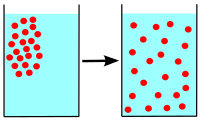
Photo from wikipedia
Photoelectrochemical devices rely on porous photoelectrodes because of the formation of heterojunctions with the electrolyte solution. We evaluate the electrolyte ion-diffusion transport in mesoscopic inverse opal (meso-IO) structures with a… Click to show full abstract
Photoelectrochemical devices rely on porous photoelectrodes because of the formation of heterojunctions with the electrolyte solution. We evaluate the electrolyte ion-diffusion transport in mesoscopic inverse opal (meso-IO) structures with a uniform pore network by comparison with the diffusion in the conventional random pore electrode. The ion diffusivity through porous photoelectrodes was obtained using the modified Fick’s law with the diffusion-limiting current in the current–voltage characteristic. We observe that the ion diffusivity of iodine-based electrolytes through the meso-IO electrode film was 1.5 times greater than that through the random pore structure. More importantly, the diffusion of larger ions, cobalt-based ions, was 58% more enhanced in the meso-IO structure than in the random pore structure. In practice, we confirmed the effect of electrolyte ion diffusion on the photovoltaic performance of the dye-sensitized solar cell, and about 11% higher efficiency at the meso-IO electrode compare...
Journal Title: Journal of Physical Chemistry C
Year Published: 2017
Link to full text (if available)
Share on Social Media: Sign Up to like & get
recommendations!